 By Angus Nicol What are your favourite pair of shoes? Are they your reliable, extra cushioned and supportive runners, your convenient and trusty thongs (or whatever you want to call them… pluggers, sandals, jandals) or styley Birkenstocks; your super fly leather boots or bootylicious high heels; or the cosiness of a good pair of fur-lined slippers/uggs? Or… do you prefer feeling the ground beneath your feet and the freedom which comes with walking barefoot? Your feet are so important. They are your first and main point of contact with the earth, and they carry the weight of the rest of the body… so having foot problems can contribute to compensatory problems throughout the rest of the body! Therefore, it is important to take care of them. I’m not here to tell you to throw all of your shoes away… they all serve their purpose. However, in this blog I would love to illuminate the features and limitations of modern conventional footwear, and conversely, and in Part II highlight the benefits of barefoot walking/using minimalist footwear, and also discuss how to ease into the transition. 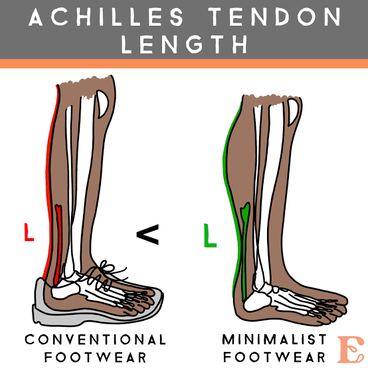 Before we go into the benefits of walking barefoot, I feel it’s important to understand shoes. I want to show you the different parts of a shoe and what their function is, and then tell you the negative effect they may be having on your feet. To try and keep it flowy, I’ll start at the back and work my way forward, and then out. The heel of many conventional shoes are thick, causing them to be more elevated than the front. The most extreme example of this is high heels, however it is present in most forms of footwear, including mens boots and most runners. Elevated heels were designed to provide cushion & support, thus providing more comfort. They also act as a shock absorber, so less force is transmitted into the heel, ankle and up through the rest of the body. Sounds ideal, right? Maybe… but there are some negative consequences which potentially outweigh these benefits. This includes shortening (and consequently “tightening”) of calf muscles. If muscles are shortened, they are unable to contract fully and strongly, so this also decreases the efficiency and strength of these muscles. They also reduce the amount of natural arch support, particularly in the main arch of the foot (the medial longitudinal arch aka MLL), which leads to the foot turning in too much (“overpronation”). Overpronation is made worse in shoes with a narrow toe box (keep reading, you’ll learn about this soon). 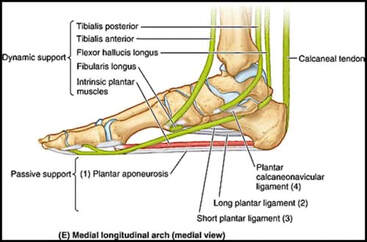 The middle part of the shoe, where your arch sits, is called the midsole. The midsole of many shoes, particularly runners, will include an inner sole (the spongy layer of foam in the bottom of the shoe) that has arch support. This arch support may be necessary due to the heel elevation and collapse of the MLL, or helpful for people with “flat feet”. However, these act as a band-aid solution to the underlying issues in the foot leading to collapsed arches. Furthermore, over time your body will adapt and may become reliant on this arch support, and the small muscles which should provide stability and maintain this arch can become lazy and weak, causing excerbation of the issue. 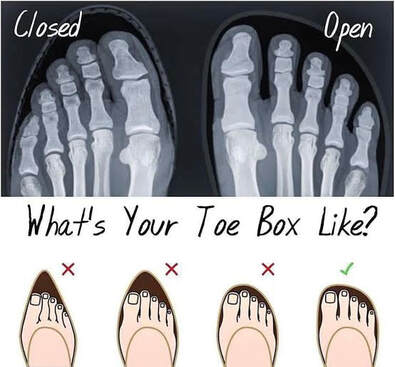 The front part of the shoe, the part that houses your toes, is aptly named the toe box. It may be sleek and stylish to have a narrow toe box that ends in a tapered point. However, this is like your forefoot having a giant squishy hug from a grizzly bear, causing compression of the bones and joints in the toes and the foot. Narrow toe boxes are a leading cause of foot injuries/conditions including bunions, hammertoes, plantar fasciosis, neuromas and ingrown toenails… just to name a few. However, the negative effects can be seen further up the kinetic chain too, and may contribute to knee osteoarthritis, shin splints and runners knee. The very end of the toe box, where the toe is pointed upwards, is known as the toe spring. It is designed to decrease rigidity of the shoe, allowing us to flow easily from heel-to-toe for a nice smooth walking pattern. However, the elevation at the front means our toes have less contact with the ground, so when shift our weight towards the toe box, most of the force is being absorbed by the metatarsals (the bones that connect our toes to the rest of our foot), which can cause or contribute to many of the conditions mentioned above. 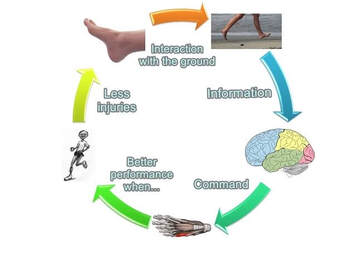 The outermost layer of the bottom (sole) of the foot is the outsole, this is the part that directly contacts the ground. These are often designed with materials that provide cushion and rigidity. However, the more cushion there is in a shoe, and the more rigid it is, the less contact and “feel” your foot has with the surface underneath. Our feet are filled with tiny nerve receptors called proprioceptors, which provide feedback to our brain about joints (and our body as a whole) “position in space”, and contributes largely to our sense of balance. Our brain receives information from proprioceptors and responds by sending messages to our muscles to contract, allowing movement in all directions, and adaptation of our feet to the surface below. The rigidity of an outsole only allows the foot to flex and extend, and less contact area between the foot and the ground means less proprioceptors are stimulated, which means that the brain receives less sensory information and less movement messages relayed back down the chain. Over time this can lead to weakening and atrophy (shrinkage) of the muscles that stabilise the arches of the foot. Phew… that was a lot to take in. Are you still with me? The good news is, that’s the hard part done. Next, I want to tell you about the benefits of walking barefoot… which to an extent, is just the reverse of the limitations of wearing footwear (plus a few extra little goodies!). Please see Part 2 of this Blog Post for the benefits of barefoot walking, how to start your barefoot journey, and some other helpful tips and hints.
0 Comments
Leave a Reply. |
HMC TEAMIf you find something of interest that might suit this space, or would like information on a specific topic, let us know at [email protected]
Archives
December 2023
Categories |
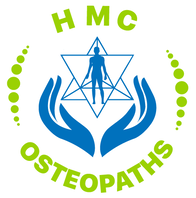

 RSS Feed
RSS Feed
